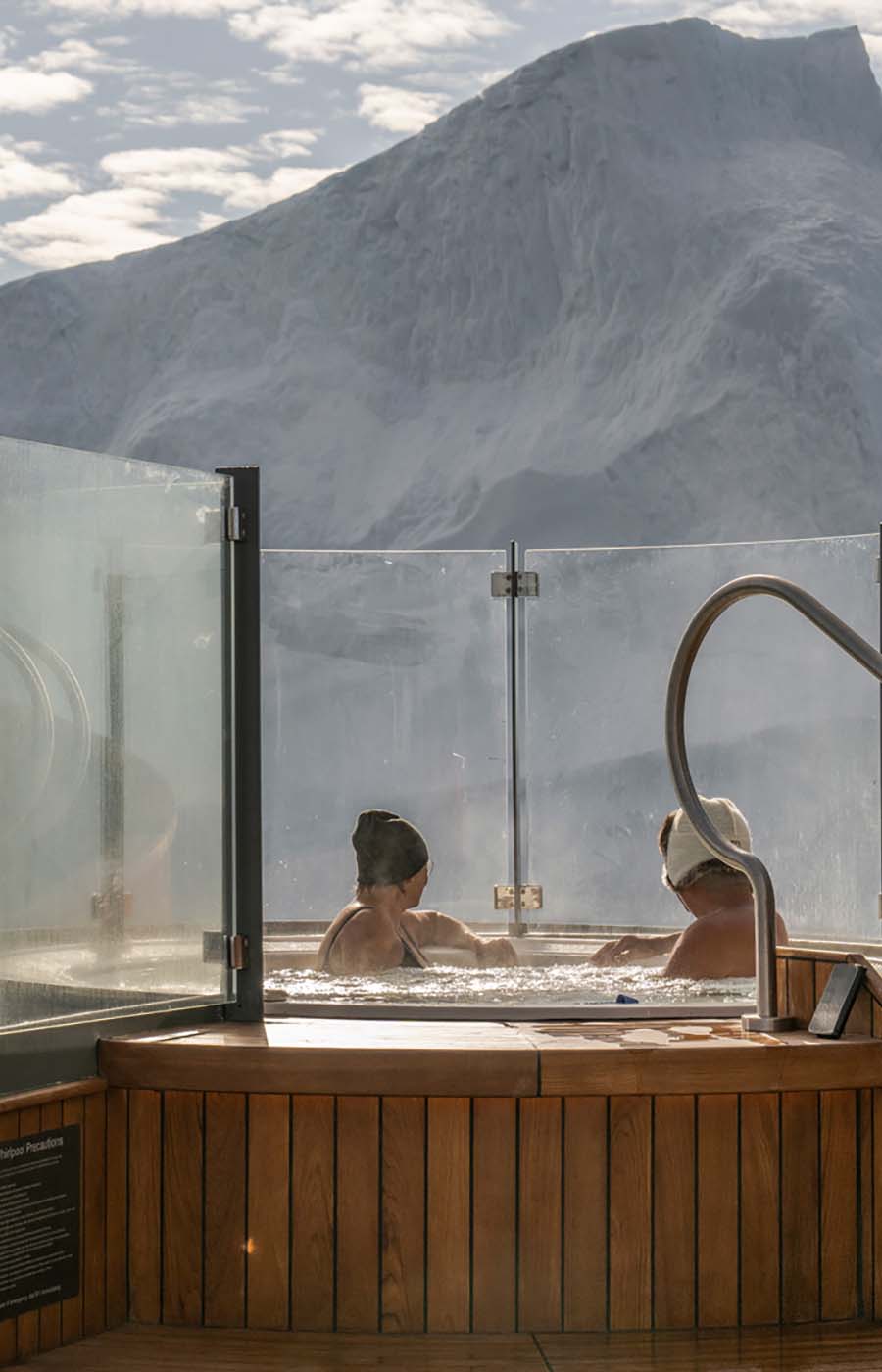The renowned mountaineer on making promises, embracing every day, and finding the courage to tell your story.
Paul Deegan, the celebrated mountaineer, wilderness explorer, and Seabourn Conversations speaker, was not always one with nature. His earliest memory of the outdoors is less than rosy: “Two nights under canvas was abhorrent to me.” On that trip, at age 7, he pledged never to spend another night in the open air.
He stayed true to that pledge for nearly a decade, until he woke up in a hospital after a near-fatal car crash. According to eyewitness reports, the car spun into the air at 80 miles an hour, making two 360-degree pirouettes before crashing down on the highway. In the backseat without a seatbelt (buckling wasn’t mandatory in the ‘80s), Deegan punched through the windshield, flew 40 feet into the air, and landed unconscious on the side of the road. Miraculously, he didn’t break a bone. That night, while reviewing his chart in the hospital, a police officer told him, “You should've died today.” Stunned, Deegan made a new pledge to himself: “To embrace every day that I was left on the planet.”
As soon as he was discharged, he wasted no time making good on that promise. “I threw myself into all kinds of activities I wouldn't have otherwise done,” he recalls, citing an impressive list of stunts, including parachuting, glider training, and convincing the Royal Air Force to include him—then only 16—to intern with one of its Scottish mountain rescue teams for three weeks.
Of all the ventures he pursued, it was being in the mountains that most captivated him. “It became a way of life very quickly,” he says. Forgoing university, he found work at an outdoor retail store so he could be around fellow mountaineers while making money for his expeditions. “I was tuned in to any and all opportunities that seemed to be circulating,” he recalls. “And when the opportunities weren't circulating, I was going out and creating those opportunities for myself.”
From venturing down Himalayan gorges deeper than the Grand Canyon to summiting uncharted mountain ranges in Central Asia, Deegan has spent the last three decades pushing the brink of not just his physical stamina, but his mental outlook. “What we think about ourselves turns into what we say about ourselves, and what we say about ourselves turns into what we do,” he explains. “It’s the mental game that we play in our heads.”
One way he reinforces that lesson is by sharing it. When he’s not mountaineering, he’s traveling to Dubai, Hong Kong, and everywhere in between to reflect on how he reaches each summit—and motivate people to reach theirs. A distinguished luminary of the Seabourn Conversations program, he relishes the opportunity to discover and experience new horizons alongside Seabourn guests. Below, we ask him about everything from the joys and challenges of nomadic living to where he’ll be venturing next.
What are the major differences between life on the mountain and life on ground level?
When you're actively engaged in expeditions, month in, month out, you don't have time to think about anything else. In a way, that focus is an absolute blessing, because you can turn your back on many of the humdrum aspects of what we might call “normal” daily life. But to live that life, you make many personal sacrifices. Things like personal relationships, for example, they're rarely compatible with that, unless the other person is equally engaged in what you yourself are doing.
On the other hand, you get a comfortable bed. You get to eat food. You get to be warm. You get to be comfortable. You get to see your friends. There's a very good chance you're going to wake up the next morning and live another day. I don't want to get too dramatic about it… but it's very different.
Over the last couple decades, you’ve spent much of your time off the mountain as a motivational speaker. What drew you to that?
One of the big privileges about standing on stage is that for 45 minutes, I get to go back to the Indian Himalaya, or the Pamirs, or Everest, or Denali. If I can take myself back there, then there's a reasonable chance I can transport every member of the audience from the comfortable seat they are in, to feel as if they are tied to the same rope as me, on the side of a mountain, or they are lying in the sleeping bag next to me in the snow hole at minus 40 degrees. Because if a guest on Seabourn or a conference attendee is going to give up 45 minutes of their time in this increasingly busy and hectic world, and sit in a room with me, then the very least I can do is to give them the opportunity to feel what I felt.
You’ve been sailing with Seabourn for eight years. What draws you to the brand?
I've worked with a lot of organizations in my life. What sets Seabourn apart for me, is that every member of Seabourn's staff, without exception, is striving for perfection. And it's that striving for perfection that's important. I've seen it again and again and again.
I've never been disappointed. Everyone there is trying to go above and beyond. Whether it's the smallest thing, or the largest gesture. Often it's the smallest gestures, in a funny way, that are the most important. Like the fact that on my last cruise, there was a guest who had a penchant for a particular type of hot chocolate that they serve at the coffee bar in Seabourn Square. And so, the staff found it and brought on an extra quantity of that particular hot chocolate, so that she would never be disappointed when she asked for hot chocolate. I see [these gestures] every day aboard a Seabourn ship.
How is speaking to travelers on Seabourn ships different from speaking to executives at corporate conferences?
The fundamental difference is that on a Seabourn ship we have time. It might be a serendipitous encounter at the poolside, or an informal coffee in Seabourn Square, or a formal hosted table in the main restaurant. For members of the audience who want to continue the conversation with me, we have ample time to do it.
Are you ever surprised by your conversations with Seabourn guests?
What I've found is that my stories are a catalyst to having other people share their stories with me. And frankly, I'm much more interested in learning about other people, about their backgrounds, and what makes them tick. Of course, we're all on a ship, so we're all interested in travel. I've met amazing guests, people who've traveled to more than 200 countries. I mean, way beyond the UN list of countries. I've met former spies who worked in Eastern Europe, before the fall of the Berlin Wall. I've met ambassadors. I've met pilots. And I’ve met people with more traditional careers. In everyone there’s an interesting story. And I’m always very keen to hear that story, if they’re happy to share it.
What has traveling with Seabourn taught you about travel in general?
Sailing with Seabourn has reinforced to me that tourism has the power to do great good. [Here’s] one example... We were on a cruise down the Amazon a couple of years ago. I got word that one of the senior officers on the ship wanted to do something about the plastic on the beach that he'd seen on the way up the Amazon. I got wind of this, and was able to join the team. Dozens of staff gave up their free time, and instead of going onshore (and that might be their only chance to get off the ship for a considerable number of days, or even weeks), they gave it up to get into the Zodiac, with the Expedition Team, and to sail to this beach and collect all of this plastic litter on the beaches.
It’s a really interesting example of a world class organization like Seabourn empowering a member of its staff, a senior officer, to invite his crew — completely volunteers only — to do something for the environment we were in.
What are the next mountains on your horizon?
I'm very keen to visit the Kingdom of Bhutan, which is a country between India and China. Unfortunately, there's no chance of going there with Seabourn [since it’s a landlocked country], so that's something I'm going to have to do on my own.
And of course, Antarctica. I've been to the Antarctic Peninsula once, a long time ago, with a gentleman who became the first person with brittle bone disease to kayak off the coast of Antarctica. But the interior of Antarctica holds a great many attractions. And I'm equally fascinated by the Chilean seaboard of Patagonia, from Santiago down to Tierra del Fuego, because the glaciers and the mountains along there are best seen from a ship — and I can't think of a finer ship to see it from than a Seabourn ship.
Related Seabourn itineraries and amenities below
When it comes to experiencing what the world has to offer, it’s tough to beat the value and capability that you get on a cruise
Explore the World’s Most Remote Destinations with Seabourn Expedition Cruises
An artist explores the stunning landscapes of Iceland, Greenland, and Canada aboard the Seabourn Quest.
Explore the Southern hemisphere with a world-class expedition team.

